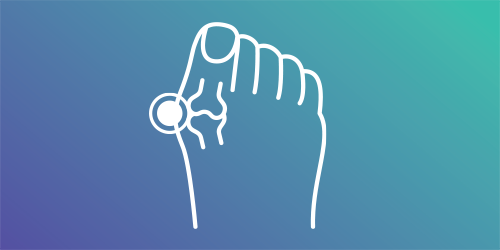
Bunions (hallux valgus) are often described as a bump on the side of the big toe. But a bunion is more than that. The visible bump actually reflects changes in the bony framework of the front part of the foot. With a bunion, the big toe leans toward the second toe, rather than pointing straight ahead. This throws the bones out of alignment, producing the bunion’s “bump.” Bunions are a progressive disorder. They begin with a leaning of the big toe, gradually changing the angle of the bones over the years and slowly producing the characteristic bump, which continues to become increasingly prominent. Bunions can be painful, but not always. Bunions are always progressive, so the deformity becomes more prounced over time, even if its not painful.Even though bunions are a common foot condition, they are probably the one with the most misconceptions. Many people suffer unnecessarily with the pain and/or appearance of bunions for years before seeking treatment out of fear about “surgery”.
The good news is that most bunion pain can be resolved without surgery!
What causes a Bunion?
Bunions are most often caused by faulty foot mechanics. It is not the bunion itself that is inherited, but certain foot types that make a person prone to developing a bunion. Although wearing shoes that crowd the toes won’t actually cause bunions in the first place, it sometimes makes the deformity progressively worse. That means you may experience symptoms sooner. Book in for a Lower Limb Musculoskeletal Assessment today and to discuss your bunion management.
Diagnosing a Bunion:
Bunions are readily apparent, you can see the prominence at the base of the big toe or side of the foot. However, to fully evaluate your condition, the Podiatrist may arrange for x-rays to be taken to determine the degree of the deformity and assess the changes that have occurred.
Because bunions are progressive, they don’t go away, and will usually get worse over time. But not all cases are alike, some bunions progress more rapidly than others. There is no clear-cut way to predict how fast a bunion will get worse. The severity of the bunion and the symptoms you have will help determine what treatment is recommended for you.
Treating Bunions:
If your bunions are causing you concern you may need to book an appointment for a Lower Limb Musculoskeletal Assessment. This Assessment is a series of clinical tests to determine the underlying cause of the pain and discomfort you are experiencing. At the end of the assessment, our Podiatrist will give you a treatment plan which may include orthotics, supported by exercises and shoe recommendations. Sometimes observation of the bunion is all that’s needed. A periodic evaluation and x-ray examination can determine if your bunion deformity is advancing, thereby reducing your chance of irreversible damage to the joint.
Early treatments are aimed at limiting the progression of the deformity and easing the pain of the bunion or an associated joint. Conservative treatments such as orthotics can achieve this but they won’t reverse the deformity itself.
At the end of your assessment, your Podiatrist my include these treatment options:
- Changes in shoe wear. Foot Mechanics Podiatrists are experts in shoe recommendation.
- Padding. Pads placed over the area of the bunion can help minimise pain, but will not stop the progression of the bunion.
- Activity modifications. Avoid activity that causes bunion pain, this could include standing for long periods of time.
- Medications. Non-steroidal anti-inflammatory drugs (NSAIDs), such as ibuprofen may help to relieve pain.
- Icing. Applying an ice pack several times a day helps reduce inflammation and pain.
- Orthotic devices. Orthotics are the mainstay of non-surgical treatment for bunions.
Orthotics for Bunions:
Orthotics are custom made and designed to optimise foot function. An orthotic can help prevent a bunion getting worse and reduce pain enabling you enjoy life without foot pain, and dysfunction. Orthotics can not re-straighten bunions, only surgery can do this.
Orthotics provide three key functions in the treatment of bunions:
- Orthotics address the underlying biomechanical foot function that leads to the formation of bunions
- Orthotics provide a physical support to the area where the bunion is forming to arrest further bunion development
- Orthotics provide deflective support for the rest of the forefoot to address the secondary problems that can occur as a result of a bunion (eg. calluses)
When is Surgery Needed?
When the pain of a bunion interferes with daily activities, and conservative treatment has been completed it’s time to discuss surgical options. Foot Mechanics has excellent relationships with many Orthopedic Surgeons, who are the specialists who perform bunion surgery.
Because bunions are caused by faulty foot mechanics surgery can improve the look of your feet by removing the “bump” but if the underlying mechanics are not addressed then the bunion is likely to return. For this reason orthotics are used post-surgery to prevent the return of bunions.

